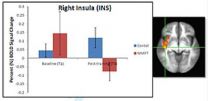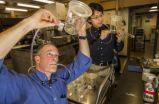(Press-News.org) Caltech researchers have found a way to make measurements that go beyond the limits imposed by quantum physics.
Today, we are capable of measuring the position of an object with unprecedented accuracy, but quantum physics and the Heisenberg uncertainty principle place fundamental limits on our ability to measure. Noise that arises as a result of the quantum nature of the fields used to make those measurements imposes what is called the "standard quantum limit." This same limit influences both the ultrasensitive measurements in nanoscale devices and the kilometer-scale gravitational wave detector at LIGO. Because of this troublesome background noise, we can never know an object's exact location, but a recent study provides a solution for rerouting some of that noise away from the measurement.
The findings were published online in the May 15 issue of Science Express.
"If you want to know where something is, you have to scatter something off of it," explains Professor of Applied Physics Keith Schwab, who led the study. "For example, if you shine light at an object, the photons that scatter off provide information about the object. But the photons don't all hit and scatter at the same time, and the random pattern of scattering creates quantum fluctuations"—that is, noise. "If you shine more light, you have increased sensitivity, but you also have more noise. Here we were looking for a way to beat the uncertainty principle—to increase sensitivity but not noise."
Schwab and his colleagues began by developing a way to actually detect the noise produced during the scattering of microwaves—electromagnetic radiation that has a wavelength longer than that of visible light. To do this, they delivered microwaves of a specific frequency to a superconducting electronic circuit, or resonator, that vibrates at 5 gigahertz—or 5 billion times per second. The electronic circuit was then coupled to a mechanical device formed of two metal plates that vibrate at around 4 megahertz—or 4 million times per second. The researchers observed that the quantum noise of the microwave field, due to the impact of individual photons, made the mechanical device shake randomly with an amplitude of 10-15 meters, about the diameter of a proton.
"Our mechanical device is a tiny square of aluminum—only 40 microns long, or about the diameter of a hair. We think of quantum mechanics as a good description for the behaviors of atoms and electrons and protons and all of that, but normally you don't think of these sorts of quantum effects manifesting themselves on somewhat macroscopic objects," Schwab says. "This is a physical manifestation of the uncertainty principle, seen in single photons impacting a somewhat macroscopic thing."
Once the researchers had a reliable mechanism for detecting the forces generated by the quantum fluctuations of microwaves on a macroscopic object, they could modify their electronic resonator, mechanical device, and mathematical approach to exclude the noise of the position and motion of the vibrating metal plates from their measurement.
The experiment shows that a) the noise is present and can be picked up by a detector, and b) it can be pushed to someplace that won't affect the measurement. "It's a way of tricking the uncertainty principle so that you can dial up the sensitivity of a detector without increasing the noise," Schwab says.
Although this experiment is mostly a fundamental exploration of the quantum nature of microwaves in mechanical devices, Schwab says that this line of research could one day lead to the observation of quantum mechanical effects in much larger mechanical structures. And that, he notes, could allow the demonstration of strange quantum mechanical properties like superposition and entanglement in large objects—for example, allowing a macroscopic object to exist in two places at once.
"Subatomic particles act in quantum ways—they have a wave-like nature—and so can atoms, and so can whole molecules since they're collections of atoms," Schwab says. "So the question then is: Can you make bigger and bigger objects behave in these weird wave-like ways? Why not? Right now we're just trying to figure out where the boundary of quantum physics is, but you never know."
INFORMATION:
This work was published in an article titled "Mechanically Detecting and Avoiding the Quantum Fluctuations of a Microwave Field." Other Caltech coauthors include senior researcher Junho Suh; graduate students Aaron J. Weinstein, Chan U. Lei, and Emma E. Wollman; and Steven K. Steinke, visitor in applied physics and materials science. The work was funded by the Institute for Quantum Information and Matter, the Defense Advanced Research Projects Agency, and the National Science Foundation. The device was fabricated in Caltech's Kavli Nanoscience Institute, of which Schwab is a codirector.
Tricking the uncertainty principle
Researchers at Caltech find a way to sidestep the quantum 'noise' that limits the precision of ultrasensitive position measurements
2014-05-16
ELSE PRESS RELEASES FROM THIS DATE:
Mothers' sleep, late in pregnancy, affects offspring's weight gain as adults
2014-05-16
Poor-quality sleep during the third trimester of pregnancy can increase the odds of weight gain and metabolic abnormalities in offspring once they reach adulthood, according to a new study published online May 8, 2014, in the journal Diabetes.
The researchers linked the excess weight and changes in metabolism to epigenetic modifications that reduce expression of the gene for adiponectin—a hormone that helps regulate several metabolic processes, including glucose regulation. Lower levels of adiponectin correlate with increased body fat and reduced activity.
"Disrupted ...
Water pipe smoking causes significant exposure to nicotine and cancer-causing agents
2014-05-16
PHILADELPHIA — Young adults who smoked water pipes in hookah bars had elevated levels of nicotine, cotinine, tobacco-related cancer-causing agents, and volatile organic compounds (VOC) in their urine, and this may increase their risk for cancer and other chronic diseases, according to a study published in Cancer Epidemiology, Biomarkers & Prevention, a journal of the American Association for Cancer Research.
"This study reports systemic intake of tobacco-specific nitrosamines and VOCs after a typical water pipe-smoking session in a hookah bar setting, thus making the ...
War and peace (of mind)
2014-05-16
Researchers from the University of California, San Diego School of Medicine and Naval Health Research Center have found that mindfulness training – a combination of meditation and body awareness exercises – can help U.S. Marine Corps personnel prepare for and recover from stressful combat situations.
The study, published in the May 16, 2014 online issue of the American Journal of Psychiatry, suggests that incorporating meditative practices into pre-deployment training might be a way to help the U.S. military reduce rising rates of stress-related health conditions, including ...
Male infertility linked to mortality in study led by Stanford researcher
2014-05-16
STANFORD, Calif. — Men who are infertile because of defects in their semen appear to be at increased risk of dying sooner than men with normal semen, according to a study led by a researcher at the Stanford University School of Medicine.
Men with two or more abnormalities in their semen were more than twice as likely to die over a roughly eight-year period as men who had normal semen, the study found.
Smoking and diabetes — either of which doubles mortality risk — both get a lot of attention, noted the study's lead author, Michael Eisenberg, MD, PhD, assistant professor ...
Magnets and kids: A dangerous duo
2014-05-16
Cincinnati, OH, May 16, 2014 -- Magnet ingestions by children have received increasing attention over the past 10 years. With the growing availability of new and stronger neodymium-iron-boron magnets being sold as "toys," there has been an increase of cases of ingestion, resulting in serious injury and, in some cases, death. In a new study scheduled for publication in The Journal of Pediatrics, researchers studied the trends of magnetic ingestions at The Hospital for Sick Children (SickKids), Canada's largest children's hospital.
Matt Strickland, MD, and colleagues ...
Study reveals 1 in 10 16-year-olds surveyed have considered self-harm
2014-05-16
One in ten 16-year-olds surveyed in a new study by Queen's University and the University of Ulster have considered self-harm or taking an overdose.
The results of the annual Young Life and Times (YLT) survey, which are published today (Friday 16 May) during Mental Health Awareness Week, also found that almost a third of 16-year-olds questioned had experienced serious personal, emotional or mental health problems at some point in the past year.
1,367 16-year-olds across Northern Ireland took part in the 2013 survey undertaken by ARK, a joint initiative by Queen's University ...
Living conditions in Iraq must improve if investment in health system is to yield results
2014-05-16
Despite enormous investment in Iraq's health system in the 10 years since the US-led invasion, the health condition of Iraqis has deteriorated and will fail to improve unless more is done to improve living conditions. A review published today in the Journal of the Royal Society of Medicine concludes that continual investment in health services is crucial to elevate the health status of the Iraqi population, but that progress will be limited without improvements in housing, water and sanitation, electricity, transport, agriculture, education and employment.
The study was ...
Interrupted breathing during sleep affects brain neurons necessary to regulate heart rate
2014-05-16
Interrupted breathing during sleep affects brain neurons necessary to regulate heart rate
Sufferers of a common sleep-breathing disorder have diminished activity among neurons responsible for keeping heart rate low, reveals a new study published today [16 May] in The Journal of Physiology.
The research discovered that in obstructive sleep apnoea (OSA), neurons in the brainstem that control heart rate experience a blunting of their activity. The reduction of neuronal activity likely contributes to the increased heart rate, blood pressure and risk of adverse cardiovascular ...
Two large meals (breakfast and lunch) better than 6 small meals with same calories for controlling weight and blood sugar in people with type 2 diabetes
2014-05-16
Research published in Diabetologia (the journal of the European Association for the Study of Diabetes) suggests that two large meals (breakfast and lunch), rather than six small meals with the same total calories, are better for controlling weight and blood sugar in people with type 2 diabetes. The research is by Dr Hana Kahleová, Diabetes Centre, Institute for Clinical and Experimental Medicine, Prague, Czech Republic, and colleagues.
The study assessed 54 patients (29 men, 25 women) treated with oral diabetes drugs, aged 30–70 years, BMI 27–50 kg/m2 and HbA1c of 6–11.8% ...
Complex interactions may matter most for longevity
2014-05-16
PROVIDENCE, R.I. [Brown University] — If studying a single gene or a diet that might extend longevity is like searching for a fountain of youth, then a new study calls for looking at something more like the whole watershed. Brown University biologists who experimentally throttled three such factors in fruit flies found that lifespan depended more on interactions among the factors than on the factors themselves.
"I think the main lesson is that these interaction effects are as significant or important as the [single] effects, such as diet effects alone or genetic effect ...
LAST 30 PRESS RELEASES:
Urban wild bees act as “microbial sensors” of city health.
New study finds where you live affects recovery after a hip fracture
Forecasting the impact of fully automated vehicle adoption on US road traffic injuries
Alcohol-related hospitalizations from 2016 to 2022
Semaglutide and hospitalizations in patients with obesity and established cardiovascular disease
Researchers ‘listen in’ to embryo-mother interactions during implantation using a culture system replicating the womb lining
How changing your diet could help save the world
How to make AI truly scalable and reliable for real-time traffic assignment?
Beyond fragmented markets: A new framework for efficient and stable ride-pooling
Can shape priors make road perception more reliable for autonomous driving?
AI tracks nearly 100 years of aging research, revealing key trends and gaps
Innovative techniques enable Italy’s first imaging of individual trapped atoms
KIER successfully develops Korea-made “calibration thermoelectric module” for measuring thermoelectric device performance
Diversifying US Midwest farming for stability and resilience
Emphasizing immigrants’ deservingness shifts attitudes
Japanese eels, climate change, and river temperature
Pusan National University researchers discover faster, smarter heat treatment for lightweight magnesium metals
China’s 2024 Gastroenterology Report: marked progress in endoscopy quality and disease management
Pusan National University researchers uncover scalable method for ultrahigh-resolution quantum dot displays
Researchers use robotics to find potential new antibiotic among hundreds of metal complexes
Gut bacteria changes at the earliest stages of inflammatory bowel disease
Scientists develop new way to “listen in” on the brain’s hidden language
Brain research: “Pulse generators” grow and shrink as memories are formed
For teens, any cannabis use may have impact on emotional health, academic performance
School meals could unlock major gains for human and planetary health
Menopause hormone therapy does not appear to impact dementia risk
Signature patterns of brain activity may help predict recovery from traumatic brain injury
Dresden study uncovers new key mechanism in cancer cells
New species are now being discovered faster than ever before, study suggests
Cannabis-based products show limited short-term benefit for chronic pain, with increased risk of adverse effects
[Press-News.org] Tricking the uncertainty principleResearchers at Caltech find a way to sidestep the quantum 'noise' that limits the precision of ultrasensitive position measurements


